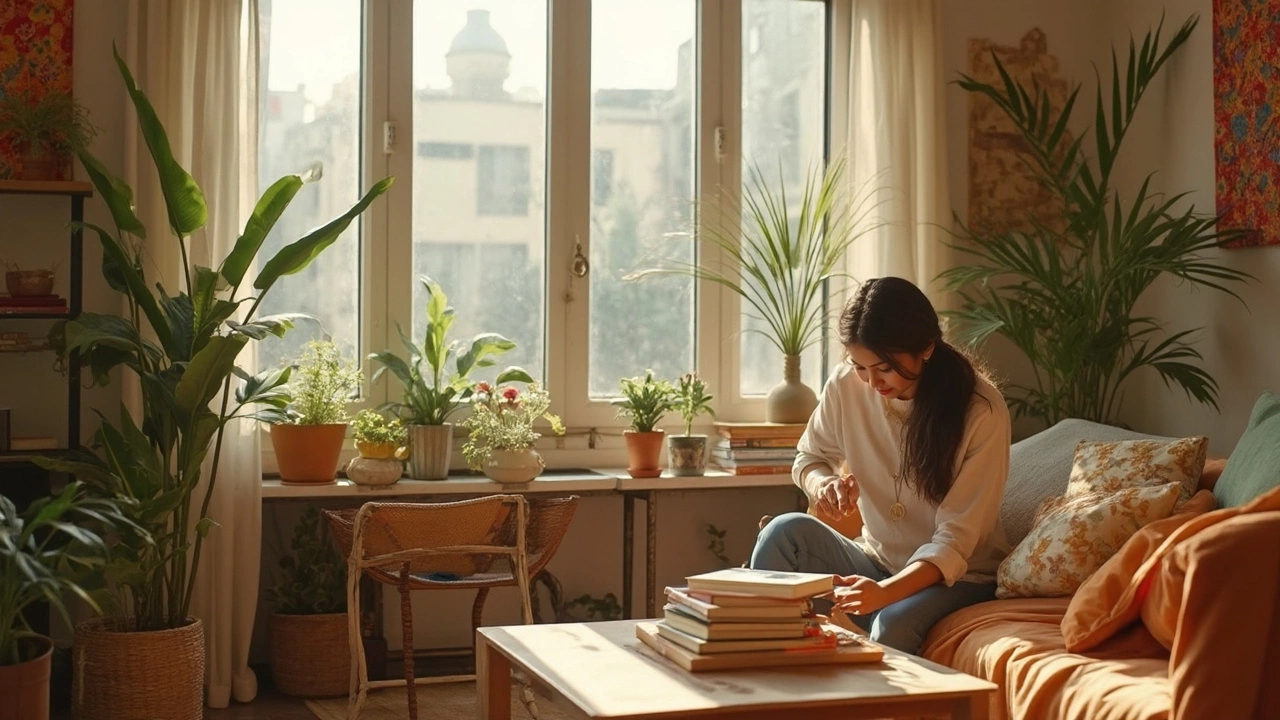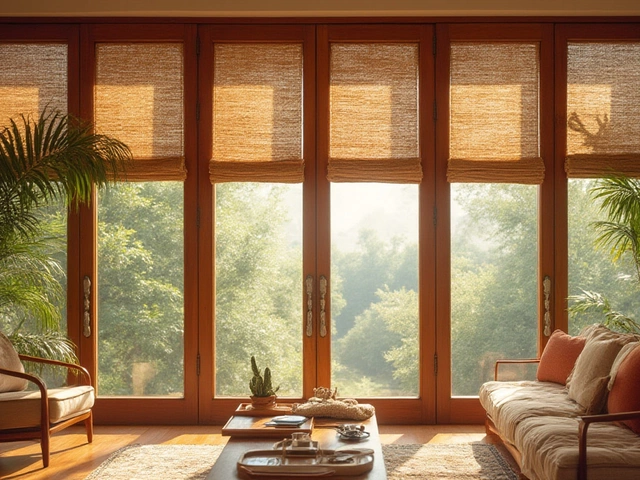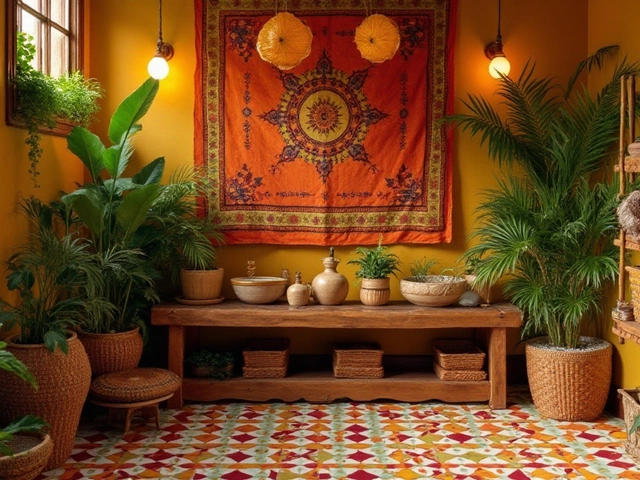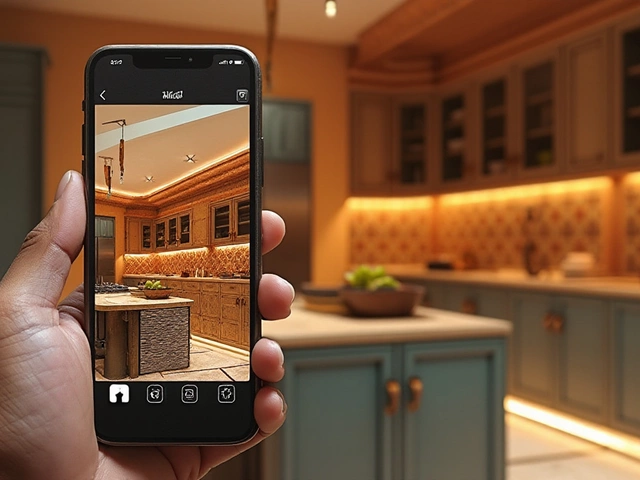Feel like you’re missing the decor gene? Good news—most people aren’t born with perfect taste. The trick isn’t to copy someone else’s fancy Instagram feed. It’s to make your living room work for real life, not just photos.
Start by looking at the big stuff. What’s already in your living room? That beat-up sofa, the weird lamp, an old coffee table—these are your building blocks. Even the ugliest peices have potential if you work with them, not against them.
If it feels like too much, focus on what bugs you most. Is the room always messy because there’s nowhere to put stuff? That’s a function problem, not a style one. Fix that first—add a simple storage basket or shelf to clear the clutter. You’ll be surprised how much neater, and yes, more stylish, your living room looks right away.
- Why Having 'No Style' Is a Good Start
- Start With What You Already Own
- Find Inspiration That Actually Works
- Simple Layout Tricks That Never Fail
- Add Personality with Quick Wins
- When to Call in Backup (And How)
Why Having 'No Style' Is a Good Start
Not having a strong sense of style isn’t a handicap—it’s actually a blank slate. Most people who think they lack style are just overwhelmed by too many options. In fact, a 2024 survey by HomeImprovement.com found that 67% of people feel stuck when decorating because they fear making the wrong choices. Having fewer set ideas makes it easier to create a space that feels real, not forced.
If you’re not chasing a certain look, you sidestep a lot of expensive mistakes. Ever bought trendy pillows or funky art, only for it to gather dust? Turns out, 42% of folks admit to regretting at least one major living room decor purchase each year, mainly because they tried to copy someone else’s style. That’s money lost and clutter gained.
Here’s what having "no style" really means for you:
- You’re free to experiment with color, patterns, and textures—without feeling boxed in by trends.
- You can focus on what the room needs: comfort, storage, function, not just looks.
- It’s easier to spot what makes you happy when you’re building from the ground up.
The biggest upside? You get to skip the anxiety over if something is "in" or "out." Instead, you make every choice about what works, not what someone else says is cool. Here’s a quick look at how most people actually approach home decorating:
| Approach | Percent of People |
|---|---|
| Copying Online Trends | 33% |
| Adapting What They Own | 45% |
| Mixing Old and New | 22% |
If you’re in the "no style" camp, you’re more likely to adapt what you have, which is the most practical and budget-friendly method. So instead of feeling behind, you’re actually in a spot with way less pressure—and a better shot at making a space that matches your real life.
Start With What You Already Own
Don’t rush out to buy new stuff if your living room makes you cringe. Most homes already have more decorating material than you’d think. Sometimes it just takes rearranging, cleaning, and a fresh eye.
In a survey by Apartment Therapy, over 60% of people said reorganizing their space made a bigger difference than shopping for new furniture. It’s easy to overlook the things you already have because you see them every day. Flip the script by moving furniture, switching around pillows, or even pulling that old chair out of the bedroom.
Here’s a simple checklist for making the most of your current pieces:
- Group similar objects together—like books or vases—to cut the visual clutter.
- Clear everything off the coffee table, then add back just one or two things you like. Less mess, more impact.
- Swap artwork or photos between rooms for a free upgrade.
- Try your rug at a new angle, or layer it with another small rug if you have one.
According to Emily Henderson, a top stylist,
“Your home already has 80% of what you need. Sometimes you just need to see your stuff in a new way.”Not everything needs to match, and perfection actually feels boring.
Here’s a look at where people usually find their best living room decor—spoiler: it’s not always in a store.
| Source | Percent Reported |
|---|---|
| Already Owned Items | 38% |
| Hand-me-downs | 19% |
| Thrift Store Finds | 27% |
| New from Store | 16% |
The takeaway: Use what’s already in your space as your starting point for living room decor. You’ll save cash, reduce waste, and probably end up with a space that actually feels like you.
Find Inspiration That Actually Works
Scrolling through endless Pinterest boards can be fun, but it can also leave you feeling lost. The key is to look for living room decor ideas that fit how you actually live, not just what looks cool. Skip those dreamy rooms with velvet couches and spotless white rugs unless you don’t mind the clean-up or price tag. Instead, focus on spaces that have a similar size, shape, or vibe as your own.
One fact you might not know: almost 70% of people say they feel overwhelmed by home design choices, according to a 2024 Houzz survey. To avoid getting stuck, pick one thing you like—a color, a pattern, or a piece of furniture. Let that guide your other decisions. If you’re drawn to that one blue cushion, try looking for other blue touches or neutral basics.
Want a shortcut? Try these:
- Check real estate listings online. Those apartment photos use simple tricks to make basic spaces look great.
- Follow everyday people on Instagram, not just designers. #MyRealLivingRoom shows spaces in action, mess and all.
- Visit big-box furniture stores’ websites. Their room setups use a few affordable pieces you can find or copy easily.
Ever notice how some living rooms just seem like they fit together, even if nothing matches? Most likely, they stick to a general color palette and repeat one or two materials (like wood or metal). Don't overthink it—grab two or three favorites and start there.
Here’s a quick snapshot of what real people say inspires them most for home decorating:
| Source | Percent of People (%) |
|---|---|
| Instagram/YouTube | 35 |
| Friends & Family Homes | 24 |
| Stores/In-Person Shopping | 22 |
| 12 | |
| Magazines & TV | 7 |
If you want your living room decor to reflect you, trust your own instincts instead of copying every trend. Set a timer for inspiration hunting—thirty minutes tops—then pick just two ideas to try. You can always change it up later. That’s how real spaces get real style.

Simple Layout Tricks That Never Fail
Let’s be honest—most living rooms are basically a couch, a table, and a TV. The magic happens in how you put them together, not what you buy. You don’t need a degree in design to figure out a layout that works. There are a few easy rules that always deliver.
First, face your biggest piece of furniture (usually the sofa) toward the spot where people naturally look—maybe that’s the TV, a big window, or the spot where friends usually hang out. Don’t just push everything against the walls. Pulling the couch in a bit actually makes a room feel cozier, not cramped.
Here’s a quick win: use your rug to anchor the space. This means making sure at least the front legs of your sofa and chairs sit on the rug. It keeps the room from floating apart and makes it look like everything belongs together. Even renters in small apartments can do this—just don’t go for a tiny doormat-sized rug. Go as big as you can.
Follow these basics for a great living room decor look:
- Make sure there’s a clear path through the room. If you trip over furniture, it’s time to move something.
- Don’t block windows with big pieces. Natural light makes any room look better and feel bigger.
- Group your seating. Even in a small spot, two chairs together or a chair next to the sofa makes things feel more inviting than lonely seating all over.
- Put your coffee table close enough so you can reach your drink but not so close you bang your knees. About 18 inches is the sweet spot for most people.
- If you get stuck, snap a quick photo of the room on your phone. You’ll notice awkward layouts way faster than you do in person.
Real talk: there’s no single right setup. Experiment. Don’t be afraid to move stuff until the room just feels good for watching TV, flopping with your phone, or having friends over. The best layouts are the ones you actually use.
Add Personality with Quick Wins
You don’t have to redo your whole living room to make it feel more like you. Little changes can make a bigger difference than you’d think. And here’s something everyone should know: Most Americans spend just under three hours a day in their living rooms, compared to under an hour in the kitchen. So it’s worth the effort to make this space comfortable and personal.
Throw pillows are the easiest win. Seriously. You don’t need a Pinterest-level eye to spot a pillow that makes you smile. Go for weird shapes, patterns you actually like, or colors that don’t match anything else in the room. That oddball choice? It’s called personality.
If the walls are plain, you don’t need fancy art. Tape up photos, postcards, or magazine clippings you like. Swap them out when you’re bored. Even a local coffee shop poster or a map can look cool when you pop it in a thrifted frame. And don’t overthink the layout—just stick stuff up and see what feels right.
Plants are another easy fix. A 2023 study found that having houseplants can cut stress levels by up to 25%. Don’t worry about turning your home into a jungle. Even a cheap pothos (they’re almost impossible to kill) can survive low light and forgetful watering.
- Keep a basket of blankets for instant coziness.
- Swap out lamp shades for ones with a fun pattern or brighter color.
- Stack a few interesting books on the coffee table—even if you’ve only read half of them.
- Switch up how you use rugs. Layer a smaller rug over a plain one for a less boring look.
Wondering what works best? Here’s a quick guide capturing what studies and pro designers recommend for small updates:
| Quick Win | Time Spent | Average Cost |
|---|---|---|
| New throw pillows | 15 minutes | $30 (for 2) |
| Starter houseplant | 10 minutes | $10 |
| Rearrange wall art/photos | 20 minutes | $0 (if using what you have) |
| Swap lamp shade | 10 minutes | $15 |
| Layer rugs | 10 minutes | $0 (if you already own them) |
Try a few of these, then step back. The point isn’t to nail a magazine look. It’s to make the place feel like you live there—with your own living room decor vibe showing through.
When to Call in Backup (And How)
Sometimes, you hit a wall. Maybe you’ve shuffled your furniture twelve times, bought throw pillows you thought you’d love, and yet your living room decor still looks off. This is when it makes sense to ask for help—no shame in it. Even interior designers turn to others for a second opinion.
If you’re constantly second-guessing every choice or can’t pin down a “look,” a fresh pair of eyes can make all the difference. A 2024 Houzz survey found that nearly 30% of homeowners who decorated their living rooms alone wished they’d at least asked a friend for advice. So yeah, you’re not alone.
Who do you call? Here are your best bets:
- Your most stylish friend: Invite them over and ask honest opinions. People love giving decor advice even if they don’t do it for a living.
- Online forums: Places like Reddit’s r/DesignMyRoom or Facebook home decor groups are packed with real people sharing photos and feedback. Snap a few pics and post your questions.
- E-design services: For under $100, sites like Modsy or Havenly let you upload photos and get pro advice without a big investment.
- Local pros: Some interior designers offer quick consults by the hour. You won’t have to commit to a whole makeover.
Here’s what’s worth having ready before calling in backup:
- Clear photos of your living room from a few angles
- Your list of what you like and what bugs you
- Room measurements or a quick sketch
- Any colors or styles you know you hate (it’s easier to say what you dislike than what you love)
Budget matters, but even a little help goes far. According to the American Society of Interior Designers, tacking on expert advice bumps reported living room satisfaction by 40%.
| Backup Option | Typical Cost | Response Time |
|---|---|---|
| Stylish Friend | $0 | ASAP |
| Online Forum | $0 | 1-48 hours |
| E-design Service | $79-$129/room | 2-14 days |
| Local Designer Consult | $50-$150/hour | Depends on scheduling |
Don’t worry about feeling clueless. As Los Angeles designer Maxwell Ryan puts it:
“Every room is fixable. Most people just need that tiny nudge to get out of a rut. You don’t need to hire a superstar—just someone honest and helpful.”
Remember, you’re not failing at decorating—you’re just smart enough to call for backup when you need real results.





